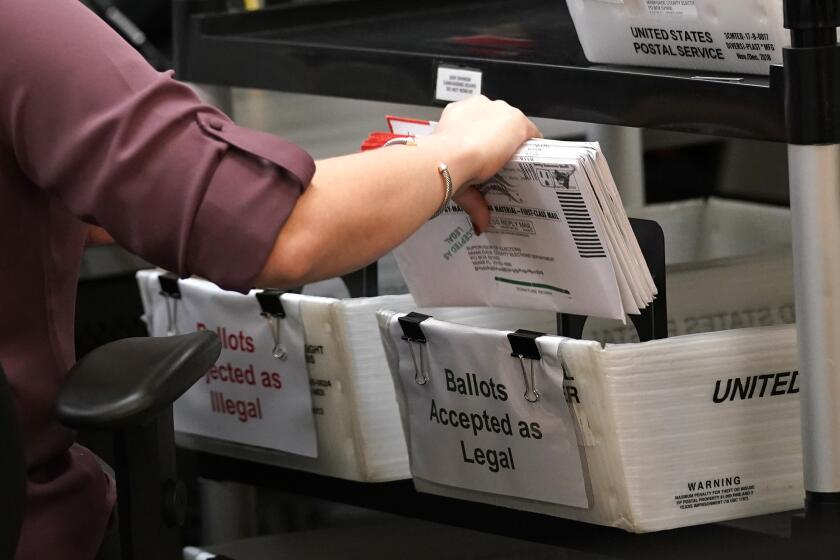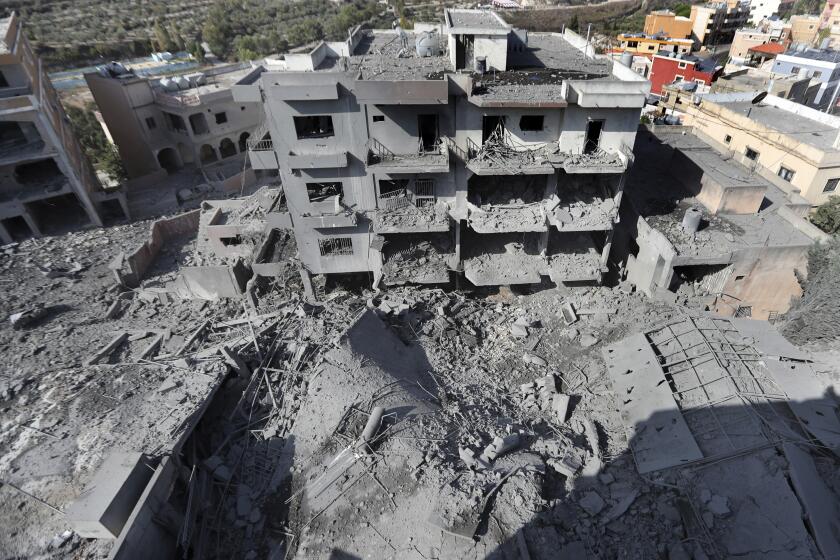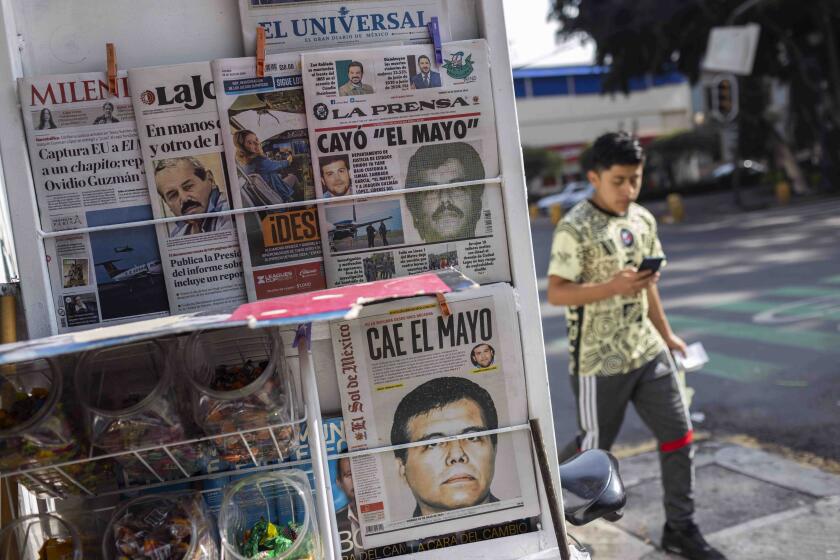A Russian Company Town’s ‘Miracle’
Every day, a miracle of loaves and fishes takes place in this Russian town.
In the gray of morning, thousands of workers emerge from concrete apartment blocks carrying empty tin lunch pails. They trudge out of town, across a snowy field and into a ramshackle set of buildings called the Tutayev Engine Factory.
They work all day but produce next to nothing. The factory loses money but is not bankrupt. No one gets paid, but they don’t go hungry. When the workers head home, they carry sacks full of bread and lunch pails full of dumplings, fish cutlets and potatoes.
It’s a form of economic magic unimaginable in the West.
“The factory feeds us,” 49-year-old Viktor Kuznetsov says between forkfuls of macaroni and chicken in one of the factory cafeterias. Near his elbow is a tin box with a cafeteria supper that he will bring home to his son. “The factory is everything to us.”
Tutayev is a company town, Russian style. In Soviet times it supplied the factory with workers, and in return, the plant supplied most of the town’s needs: food, homes, heat, electricity, day care.
Seven years after the collapse of the Soviet Union, Russian industry has largely ground to a halt. This plant, which once built 12,000 diesel engines a year, produced 222 in 1998.
Yet the factory has not gone into bankruptcy. It has not had layoffs. Defying the laws of economics, the Tutayev factory has stayed open. And it has kept feeding the town’s 50,000 residents.
“In economic terms, what happens here makes no sense,” factory Director Boris N. Peshkov admits. “It’s absurd, nonsense.”
It may not make sense, but it happens every day in towns across Russia.
Tutayev is a microcosm of this nation’s many economic ills. And the story of why the town is still working and eating helps explain why the Russian economy continues to confound Western diagnosis and prescription.
Bruce Bean, chairman of the American Chamber of Commerce in Russia, expresses admiration for Russian survival skills.
“It’s as if the laws of economics are in suspended animation,” he says.
The first step to understanding Tutayev’s economy is to realize that it is effectively cashless.
Nina Protasova is a lathe operator. Her hands shake as she opens her wallet and fingers tiny coins--single kopecks, each worth about 1/25 of a cent. All together, the coins add up to less than 1 ruble, or about 4 cents.
Officially, she and her husband, a metalworker, each make about $35 a month. However, each has received less than one month’s salary in cash since last March.
“I don’t understand why they don’t pay us,” the 39-year-old says. “We make things. There’s some production. But there’s no money.”
What they earn instead are coupons--ration tickets issued by the factory that can be used for bread or dinner in the cafeteria. One meal coupon costs about 25 cents and is deducted from what the factory owes Protasova in back wages. A bread coupon of similar value will buy one loaf of white and one loaf of rye at the factory bread counter.
Children Get Coupons for School Lunches
The coupon system extends into the town as well. Protasova’s two children get coupons for school lunches--a ticket worth about 12 cents pays for a roll or meat pie and a glass of tea. Last summer, it was even possible to use a factory coupon to get a hairdo at a salon.
The coupons are currency in a local barter economy centered on the factory. The plant gets bread from the local bakery in return for supplying it with truck parts and a delivery fleet. Similar arrangements with local farms provide the food for the cafeteria. When a nearby clothing factory needs truck parts, dresses appear in the company coupon store.
Protasova doesn’t like the coupon system, and she tries to limit the portion of her earnings she receives that way. Meals at home consist almost entirely of produce from a garden plot provided by the factory. A typical supper is home-grown potatoes and cucumbers.
“I spend all my time thinking about how I’m going to feed my children,” she says.
Her worries are intensifying. Last year’s potato harvest was the worst in decades. Usually Protasova and her family gather about 15 sacks of potatoes from their garden, each weighing 100 pounds. But this year they harvested only 10 sacks, and they are halfway through the last one. They already have exhausted their store-bought supplies, such as sugar and cooking oil. It’s been months since she’s been able to buy milk for her 11-year-old son.
As long as the factory supplies bread, Protasova says, they won’t starve. But they won’t thrive.
She sighs, her hands resting limply in her lap. “I never thought we would live this way.”
Money Played Tiny Role in Soviet Era
Money may be the lifeblood of capitalism, but it was largely irrelevant to the Soviet economy that built Tutayev, about 150 miles northeast of Moscow. Factories produced what the government told them to, using raw materials the government delivered, and only used cash--provided by the government--to pay nominal wages to the workers.
Factory Director Peshkov compares the Russian economy to a beast with two hearts. If one heart stops beating, the animal will be very ill. But it may take a long time to die.
“The Soviet economy had two circulatory systems, and only one of them was cash,” he says. “These days only 5% to 6% of our transactions are in real money.”
Peshkov knows how a market economy is supposed to work. In the early 1990s, he spent a year studying finance and management at George Washington University in Washington. He spent another year studying diesel engine manufacturing at a plant in Ohio.
“What I learned in the United States doesn’t translate to here,” he says.
Western economic theory teaches faith in the “invisible hand” of the market. Americans have preached this credo to Russians for years, urging them to put property in private hands and let the market work. Good businesses will grow, the Americans promised; inefficient businesses will die.
Yet how well do Western theories work in a nonmonetary economy? Without money to set prices and serve as a common unit of exchange, measures such as gross domestic product and money supply are suspect. And policies based on those numbers are likely to be ineffective or even backfire.
Indeed, the vast majority of economic activity in Tutayev is not reflected in economic statistics. The factory earned about $15 million in cash last year. That works out to about $300 per Tutayev resident. If this town were a country, its official per capita income in cash would be about one-quarter that of Bangladesh.
“There’s no monetary fix on the problem,” complains Barry Ickes, a professor of economics at Pennsylvania State University, who points out that in terms of real money, plants such as the one in Tutayev aren’t just inefficient, they actually destroy economic value.
Towns’ Economies Are Like Black Holes
Peshkov concedes the point. He estimates that, on paper, it costs the plant about 1.33 rubles to produce about 1 ruble of output.
In fact, the economies of towns such as Tutayev are a bit like black holes: You can’t see them, can’t measure them, but they suck up whatever resources are around them. Russia’s economic universe has more black holes than stars.
What if Western economic theories were put into effect in Tutayev? What if the factory laid off its workers and shut down operations? What if it shut the cafeteria, closed the bread counter and stopped issuing coupons?
That is Nina Nefedyeva’s nightmare. She runs the town’s unemployment office, and she knows maybe better than anyone that Tutayev’s workers have nowhere else to go. There are no other significant businesses in town. Workers can’t commute out of the area because virtually none have cars, and public transportation is spotty. There is almost no way to find out about jobs elsewhere in the country, and no way to move even if there were.
“The town could become a danger zone,” she says, imagining the unemployed roaming the streets, looting houses and stealing anything they can. “You should be ready for anything. Hungry people are evil people.”
In the United States, which is enjoying its longest postwar economic boom, about 50,000 businesses go bankrupt every year. In Russia, which has been suffering through one of the century’s deepest depressions, there have been fewer than 2,300 bankruptcies in the past seven years. By nearly any Western measure, the Tutayev factory ought not to exist. However, Russia uses different measures.
Take profit. In the West, the bottom line for any company is whether it earns more than it spends. But Russian accounting practices still bypass profit to focus on “production.” And if, like Tutayev, a factory is producing something--no matter how little--the company is not seen as bankrupt.
In fact, the word “bankruptcy” in Russia doesn’t so much mean a business failure as a moral failure.
“Why doesn’t the factory go into bankruptcy?” Tutayev Mayor Yuri I. Zelinsky asks rhetorically. “Because we don’t give up so easily. We have to hang on until victory. Russia lived through the war. We’ve lived through worse. We can live through this.”
Director Is Prevented From Firing Workers
Besides, the mechanics of bankruptcy are not so easy in Russia. For instance, Peshkov is not allowed to lay off the factory’s 8,500 workers. Under Russian law, a privatized factory must sell off 75% of its shares before it can fire workers. Tutayev has been able to sell only about 68%.
Moreover, Russia lacks many of the legal and financial processes needed for bankruptcy, such as markets where assets can be liquidated and courts with clear jurisdiction.
“In the United States, bankruptcy is a normal process where signboards change and a new owner steps in,” Peshkov says. “Here, there’s no one to buy the plant. If we are bankrupted, nothing would take our place.”
Bankruptcy is not Tutayev’s only option. Several American engine manufacturers who have visited Tutayev with an eye on investing say the plant could have a future as a component supplier for European producers, or an assembly center for European engines heading for the Russian market.
The one thing potential foreign investors say the plant will never do again is precisely what it was built to do: make large engines on a large scale.
Even under the best-case scenario, only a fraction of Tutayev’s workers would find new employment in a streamlined, foreign-run plant like that. And the revamped factory would not feed the town.
Economist Ickes agrees that many in the West have overestimated the power of “the market” and underestimated the depth of Russia’s structural problems. After all, unlike Eastern Europe, Russia never had a functioning market economy before it built a planned one.
“Russia needs some breathing room,” he says, to gradually dismantle its current economy. Accounting practices have to change. Factories must be slowly whittled down to efficient size. A social safety net must be put in place to support those dislocated.
Foreigners could lend a hand by writing off Soviet-era debt, Ickes says. And perhaps most important, they could accept that there are no quick fixes, for Tutayev or for Russia as a whole.
Valery Shabanov, a 58-year-old metalworker here who has been waiting for his pay for eight months, says he’s ready to stick it out longer.
Until someone comes up with a solution for the factory, he’ll walk to work each morning, spend his day bumming cigarettes, and eat a big dinner in the cafeteria.
“Here, at least, there’s something to wait for,” he says, slurping his cabbage soup in the cafeteria. “We’re used to waiting. We’ve done it for years.”
More to Read
Sign up for Essential California
The most important California stories and recommendations in your inbox every morning.
You may occasionally receive promotional content from the Los Angeles Times.










